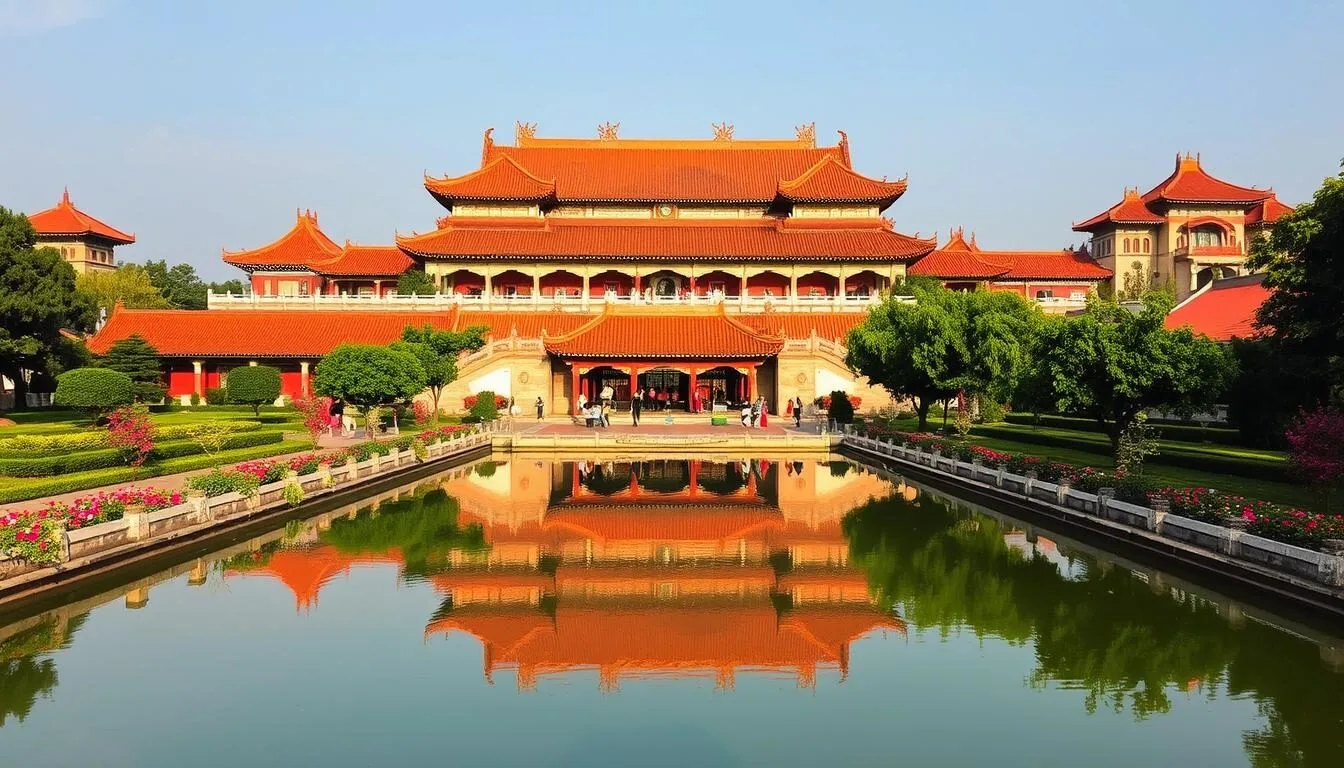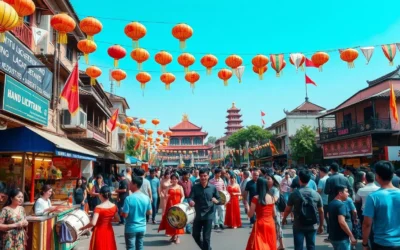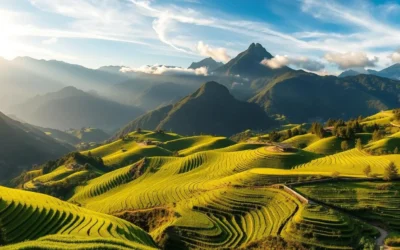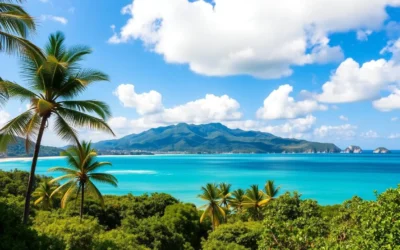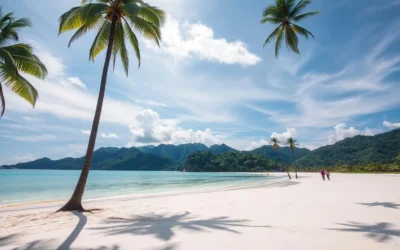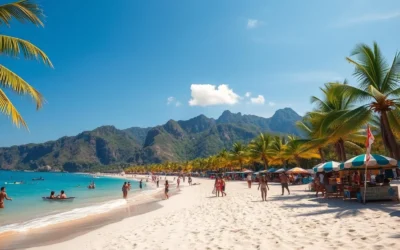✓ Accommodations ✓ Flights ✓ Rental Cars
You may not know that Hue, once the imperial capital of Vietnam, is home to more than 20 monuments, including tombs, temples, and the Imperial City, a UNESCO World Heritage Site. This city is a treasure trove of history, culture, and natural beauty.
As you explore Hue, you’ll uncover the rich heritage of the Nguyen Dynasty, which ruled from 1802 to 1945. From the intricate architecture of the Imperial City to the serene beauty of the Perfume River, Hue offers a unique blend of royal history and cultural experiences. You’ll have the opportunity to savor local culinary delights and discover the city’s distinctive charm.
With its blend of history, beauty, and culture, Hue is a must-visit destination in Vietnam. In this guide, we’ll take you through the top picks for things to do and experience the best of Hue.
Discovering the Ancient Imperial Capital of Vietnam
Discover the essence of Vietnam’s past in Hue, where the imperial city’s legacy continues to captivate visitors. As the former capital of Vietnam during the Nguyen Dynasty, Hue is a city steeped in history and architectural grandeur.
A Brief History of Hue
Hue’s rich history dates back to the early 19th century when Emperor Gia Long established it as the political, cultural, and religious center of Vietnam. The city’s imperial architecture and layout were designed according to ancient feng shui principles and Chinese influences, reflecting the Nguyen Dynasty’s profound impact on Vietnamese culture. For over a century, from 1802 to 1945, Hue served as the imperial capital, leaving behind a legacy of historical landmarks, including the Imperial City and numerous pagodas.
- The Nguyen Dynasty’s rule shaped Hue’s identity as a cultural and religious hub.
- The city’s architecture is a testament to its historical significance, with structures designed to reflect ancient feng shui principles.
- Hue’s imperial city is a must-visit attraction, offering insights into Vietnam’s royal past.
Best Time to Visit Hue
The best time to visit Hue is during the dry season, from February to April, when the weather is moderate and rainfall is minimal. In contrast, the rainy season, which begins in September and lasts until November, can make travel risky due to heavy downpours and potential flooding. While December and January can still experience occasional rain, these months coincide with the peak holiday season, including the Lunar New Year (Tet), when prices for accommodations and tours may increase. It’s advisable to book in advance during this period.
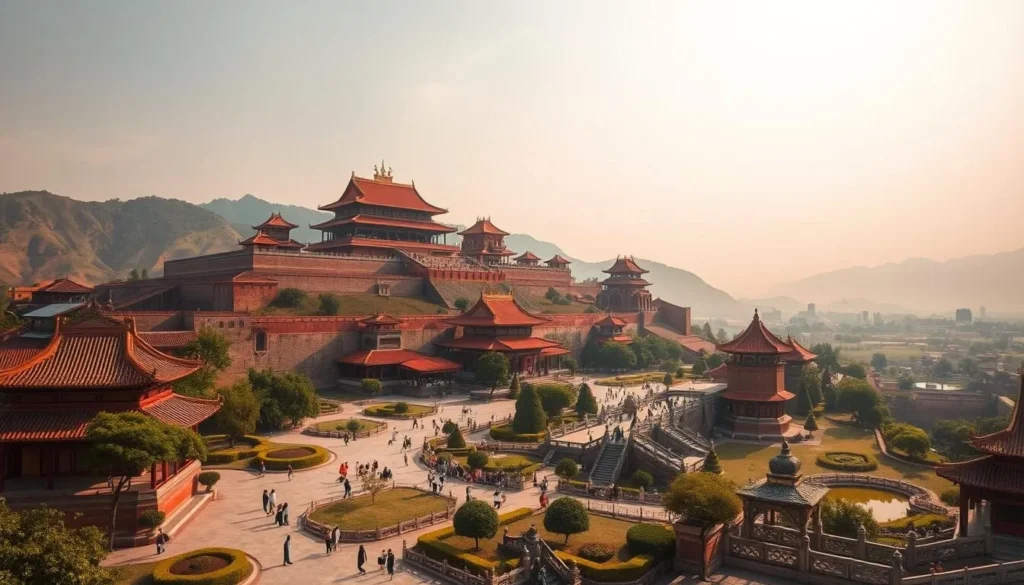
Visiting Hue during the dry season ensures a more enjoyable experience, allowing you to explore the city’s historical sites without the hindrance of harsh weather conditions. Be mindful of the peak tourist seasons and plan accordingly to make the most of your visit.
How to Get to Hue and Get Around
Whether you’re coming from Hanoi or Ho Chi Minh City, you have several ways to reach Hue, a city steeped in history and culture. The city is well-connected by bus, train, and air, making it accessible for travelers from various directions.
Transportation Options to Hue
Hue is easily accessible by train via the Reunification Express Railway, which connects major Vietnamese cities. The journey from Hanoi takes around 14 hours, while from Ho Chi Minh City, it takes at least 20 hours. Tickets can be booked in advance through services like 12Go or Baolau, with prices starting from 500k dong for a one-way ride. For shorter distances, such as from Phong Nha, Danang, or Hoi An, bus rides are a comfortable option, taking up to 4 hours. Alternatively, Phu Bai International Airport offers domestic flights from Hanoi and Ho Chi Minh City, though international flights are limited.
Getting Around the City
Once in Hue, getting around the city is relatively straightforward. The central areas are easily explored on foot. For longer distances or a more leisurely experience, ride-hailing apps like Grab are convenient. Traditional cyclos offer a nostalgic way to see the sights. For those who prefer independence, renting motorbikes or bicycles is a great option, though be sure to follow local traffic regulations and safety tips. Organized tours are also available for visiting attractions outside the city center, such as the royal tombs, providing a hassle-free experience.
Explore the Imperial City and Citadel
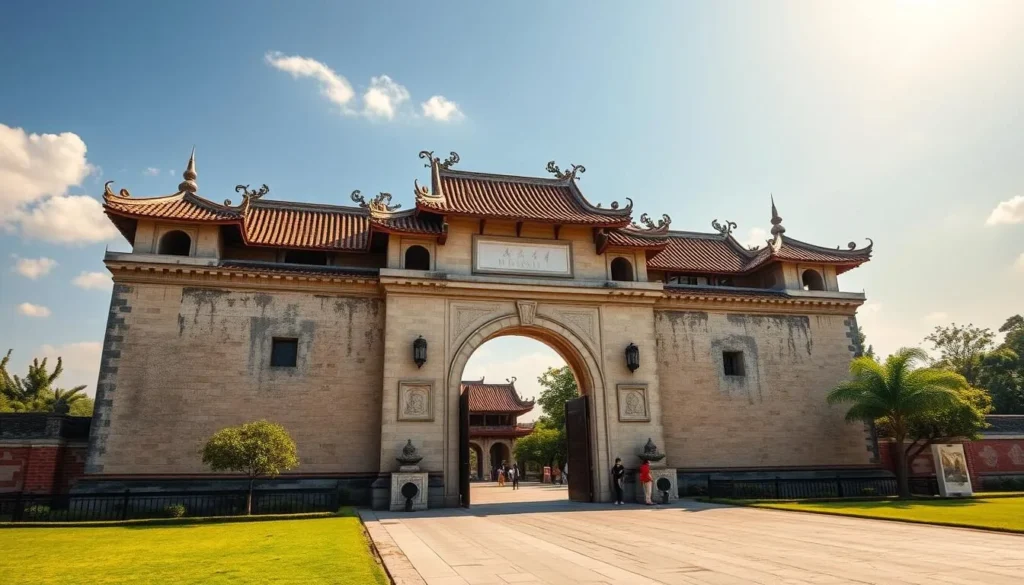
With its rich history and stunning architecture, the Imperial City is Hue’s centerpiece attraction. As a UNESCO World Heritage site, it served as the political center of Vietnam for 143 years. The massive walled complex is surrounded by a moat and features numerous temples, pavilions, and residences.
The Forbidden Purple City
The Forbidden Purple City, the innermost enclosure, was reserved exclusively for the emperor and his family. This area was once off-limits to the public, and its distinctive architecture and historical significance make it a fascinating part of the complex. Unfortunately, much of this area was damaged during the Vietnam War, but its remnants still evoke a sense of imperial grandeur.
Practical Tips for Visiting
Entry to the Hue Imperial Citadel costs about 230,000 VND. Consider purchasing a combo ticket if you plan to visit other royal tombs. An audio guide is available for an additional 100,000 VND, enhancing your understanding of the site’s historical context and architectural details. The citadel is open daily from 8 AM to 5 PM. Allocate 2-3 hours for a thorough exploration to avoid the crowds and heat.
Visitors can explore the complex on their own or hire a guide. To fully appreciate the historical significance and architectural nuances, an audio guide or a guided tour is recommended.
Visit the Royal Tombs of Nguyen Dynasty
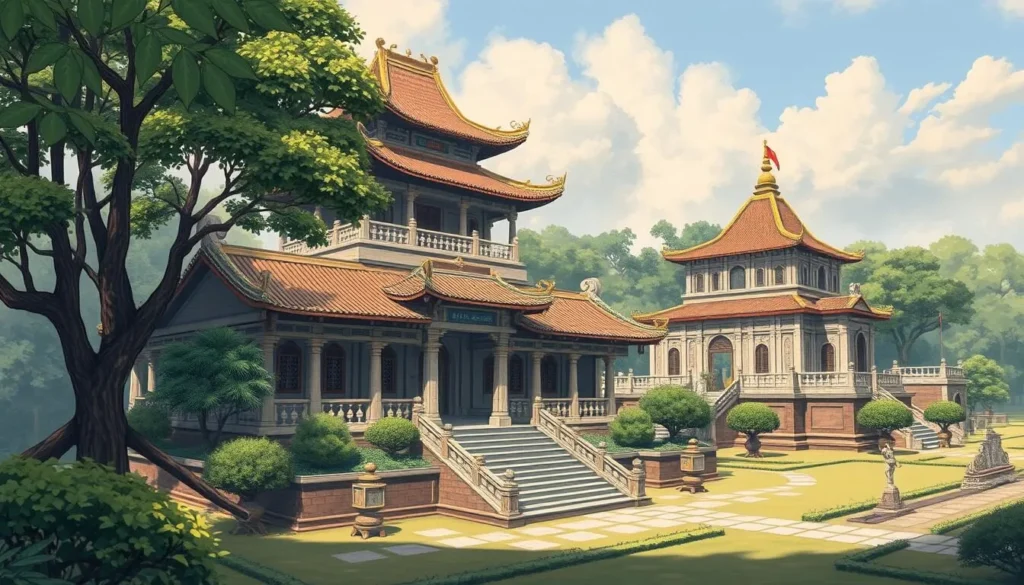
As you explore the historical landscape of Hue, Vietnam, you’ll discover the majestic Royal Tombs of the Nguyen Dynasty. These tombs are not just final resting places for the emperors but also embody the rich cultural heritage and history of Vietnam.
The Nguyen Dynasty, which ruled Vietnam from 1802 to 1945, had thirteen emperors, and seven tombs house the remains of nine of them. The most visited tombs are those of Minh Mang, the second emperor, Tu Duc, the fourth emperor, and Khai Dinh, the father of the last emperor.
Khai Dinh Tomb
The Khai Dinh Tomb stands out for its unique blend of Vietnamese and Western architectural styles. This tomb is a testament to the eccentric tastes of Emperor Khai Dinh, who spared no expense in its construction, even increasing taxes to fund this extravagant project.
The tomb’s elaborate stone carvings, colorful glass, and ceramic decorations make it a sight to behold. Unlike other tombs, Khai Dinh’s tomb has the smallest land space but is considered the most expensive to build.
Tu Duc Tomb
Tu Duc Tomb is another significant site, serving both as a retreat during the emperor’s lifetime and his eventual burial site. The expansive grounds include pavilions, lakes, and gardens, reflecting the emperor’s love for nature and tranquility.
This tomb is a perfect example of how the Nguyen emperors integrated their living and resting places with nature, creating harmonious and serene environments.
Minh Mang Tomb
The Minh Mang Tomb is renowned for its symmetrical layout and harmonious integration with the natural landscape, reflecting the emperor’s Confucian values. Built seven years after his enthronement, the complex was carefully constructed with good feng shui in mind.
The tomb features three gates on the main axis and several pavilions and temples on both sides, creating a sense of balance and harmony. The artificial lakes and the forested hill add to the auspiciousness of the site.
Visiting these Royal Tombs provides a unique insight into the history and traditions of the Nguyen Dynasty. Practical information such as their locations outside the city center, entrance fees, and transportation options can help plan your visit.
Understanding the cultural significance of these tombs is crucial to appreciating Vietnamese history and the royal traditions of the Nguyen Dynasty.
Cruise the Perfume River

Discover the serene beauty of Hue from the Perfume River, a journey that combines tranquility with scenic views. The Perfume River, or Huong River, is the lifeblood of Hue, and its poetic name originates from the fragrant flowers that once fell into its waters.
As you cruise along the Perfume River, you’ll be treated to a unique perspective on Hue’s landmarks. The river winds its way through the city, offering glimpses of historical sites, lush gardens, and traditional garden houses.
Dragon Boat Experiences
Traditional dragon boat experiences allow visitors to enjoy the peaceful atmosphere of the river while taking in the sights. These boats are designed to resemble dragons, adding to the cultural and historical ambiance of the cruise.
Sunset Cruises
For a romantic experience, consider a sunset cruise. As the day comes to a close, the changing colors of the sky reflect on the water, illuminating Hue’s skyline and casting a warm glow over the river. It’s a truly magical way to appreciate the beauty of Hue.
Various boat cruise options are available, ranging from short 30-minute rides to longer dinner cruises accompanied by traditional music performances. You can choose a cruise that fits your schedule and preferences, ensuring a memorable visit to Hue.
To make the most of your Perfume River cruise, consider the timing. Early morning or late afternoon cruises are recommended to avoid the midday heat and capture the most photogenic lighting conditions.
Discover Thien Mu Pagoda
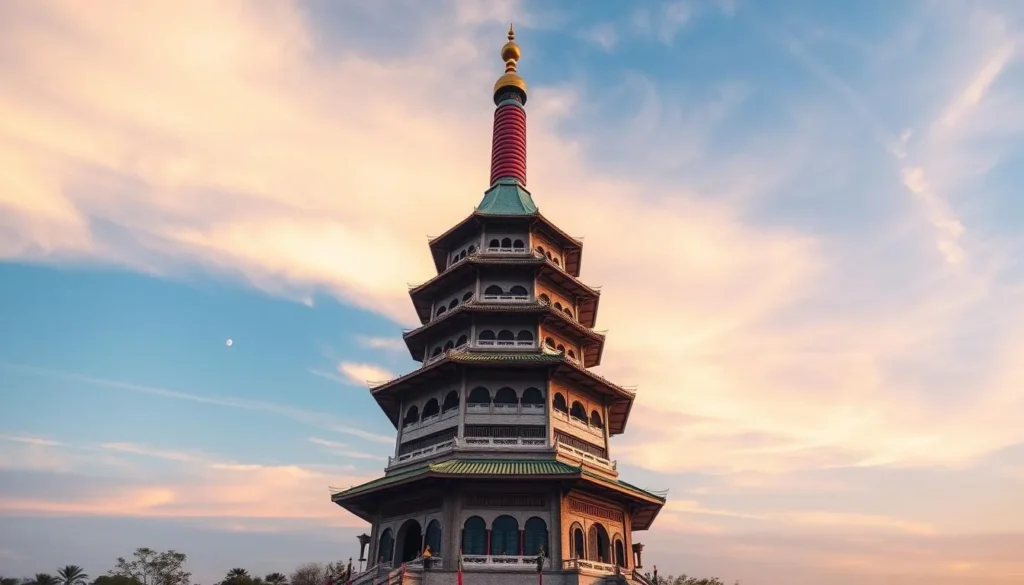
Perched on a hill overlooking the Perfume River, Thien Mu Pagoda is a must-visit destination in Hue, Vietnam. This iconic pagoda, also known as Linh Mu Pagoda, has been a significant religious site since its construction in 1601.
The Legend and History
The story behind Thien Mu Pagoda’s construction is rooted in legend. An old lady, known as Thien Mu or “Heavenly Lady,” prophesied that a lord would build a pagoda on the hill to bring prosperity to the region. Soon after, a lord appeared and followed her plans, naming the pagoda in her honor. This striking seven-tiered pagoda has survived various calamities and is now considered the unofficial icon of Hue.
The pagoda’s historical significance extends beyond its architecture. It has played a crucial role as both a religious center and a site of political protest during Vietnam’s turbulent history.
What to See at the Pagoda
Visitors to Thien Mu Pagoda can explore several key features within the complex. The iconic seven-story octagonal tower stands at 21 meters tall and is a prominent landmark. Other notable structures include a massive bronze bell, considered one of the greatest achievements in bronze casting, and a stela set on the back of a large marble turtle.
Additionally, the pagoda houses the historic Austin car driven by monk Thich Quang Duc during his self-immolation protest in 1963. This vehicle is now preserved at the pagoda as a symbol of the monk’s sacrifice.
Visiting Thien Mu Pagoda is free, and it is open daily from 8 AM to 5 PM. You can reach the pagoda by car along the riverbank or by boat, offering a serene approach to this sacred site.
Hue, Vietnam: Best Things to Do – Top Picks for Food Lovers
As a food lover, you’ll find Hue, Vietnam, to be a treasure trove of flavors. The city’s cuisine is a reflection of its rich history and cultural heritage, shaped by its royal past and local traditions. Hue’s distinctive cuisine is a must-experience for any visitor.
Must-Try Hue Specialties
When in Hue, there are several local specialties you shouldn’t miss. Bun Bo Hue, a spicy beef noodle soup, is a standout dish that’s more complex and flavorful than the popular pho. The soup’s rich flavor profile comes from a combination of lemongrass, shrimp paste, and chili oil. Another must-try is Nem Lui, lemongrass pork skewers that are eaten hot with rice paper and peanut sauce.
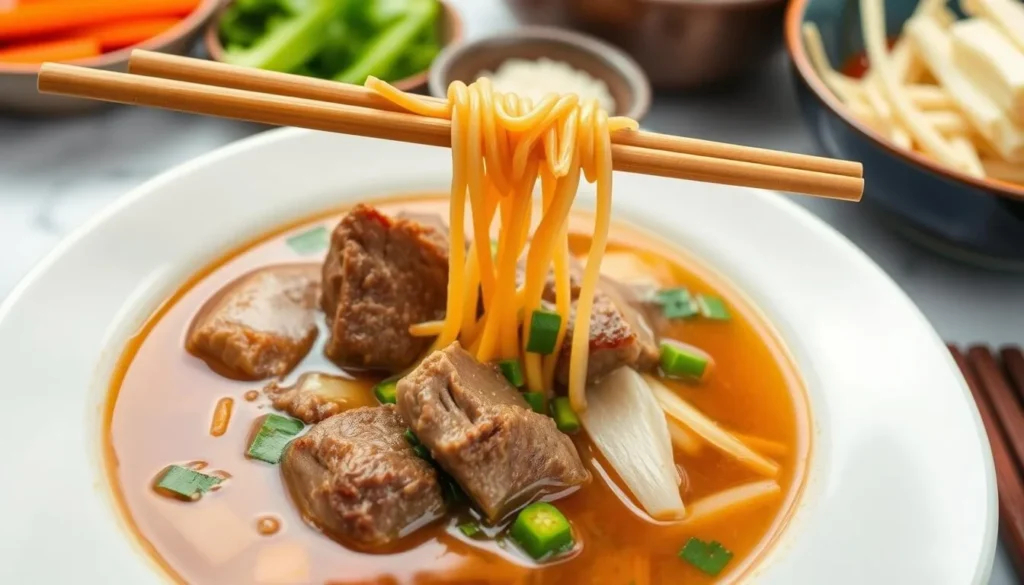
Other Hue specialties include Banh Khoai, crispy rice pancakes, and various small steamed rice cakes like Banh Beo, Banh Nam, and Banh Loc. These dishes showcase the diversity and richness of Hue’s food scene.
Where to Eat in Hue
To experience the best of Hue’s cuisine, you can dine at various places, from street food stalls and local markets to upscale restaurants serving traditional dishes. For a truly immersive experience, consider joining a guided food tour. This will allow you to sample multiple dishes while learning about their cultural and historical significance from knowledgeable guides.
By exploring the local food scene, you’ll get to interact with the friendly locals and people of Hue, gaining a deeper understanding of the city’s culture and traditions. Whether you’re trying the various things to eat or drinking the unique Ca Phe Muoi, a special salted coffee, you’ll be experiencing the best of Hue.
Experience a Royal Banquet Dinner
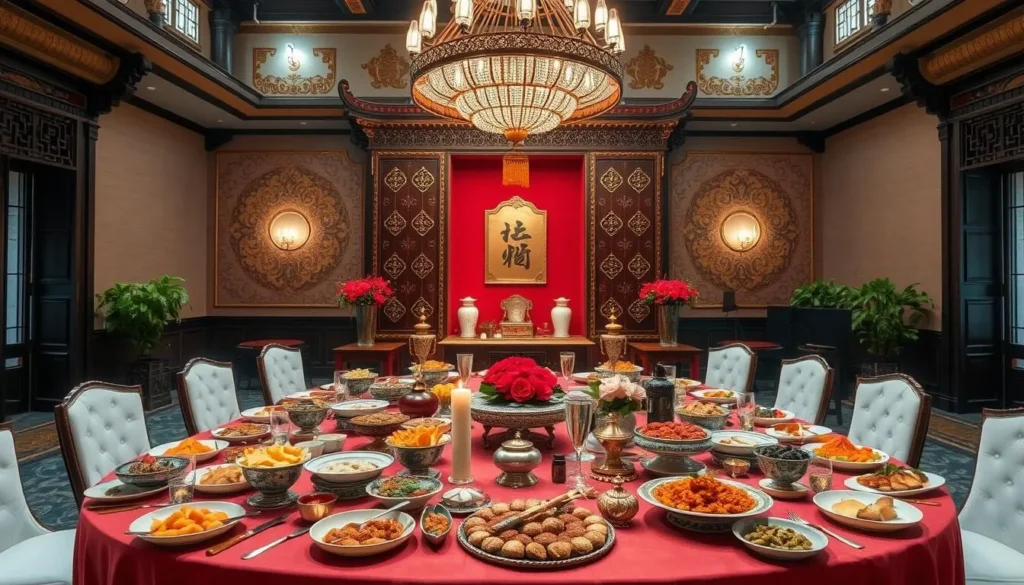
Savor the flavors of the Nguyen Dynasty at a royal banquet dinner, a unique culinary adventure in Hue. You will have the opportunity to dress up like Vietnamese royalty, enjoy traditional music, and dine on dishes once reserved for the imperial family.
What to Expect
During a royal dining experience, you can expect elaborate presentation, multiple courses, and a range of traditional “royal” dishes. The ceremonial aspects of the banquet, including traditional costumes and music performances, recreate the atmosphere of imperial feasts. The artistry involved in royal cuisine is evident in its emphasis on balance, aesthetics, and symbolic meanings behind certain ingredients and presentations.
Best Places for Royal Dining
Hue offers several venues for an authentic royal dining experience. You can enjoy a luxurious dinner on a cruise along the Perfume River or dine in a high-end restaurant within a historic building. Some popular options include riverside restaurants that offer stunning views and establishments that specialize in imperial cuisine.
When planning your royal banquet dinner, consider the pricing, reservation requirements, and options for different group sizes and dietary preferences to ensure a memorable experience for you and your companions.
Explore Traditional Villages and Crafts
The traditional villages around Hue are a treasure trove of Vietnamese culture and heritage, offering a unique glimpse into the country’s rich history and rural life. You can experience the authentic culture of Vietnam by visiting these villages, where ancient traditions and crafts are still alive.
Thuy Bieu Eco-Village
Thuy Bieu Eco-Village is a peaceful riverside community known for its ancient garden houses and fruit orchards. You can experience the daily life of the locals and people living in the village, gaining insight into their traditional way of living. The village is a perfect example of Vietnamese rural life, where you can see the art of traditional crafting being practiced.
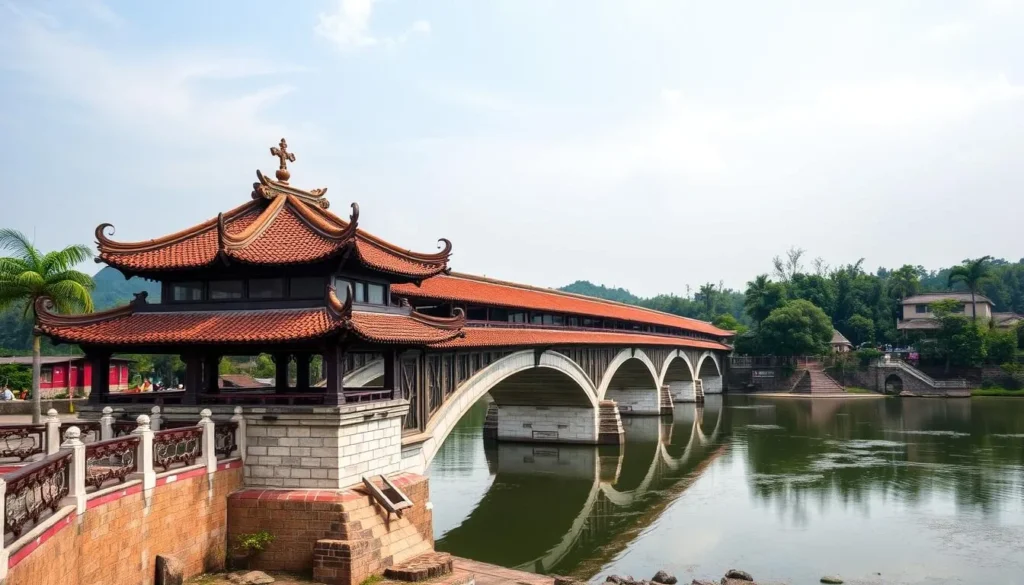
Thanh Toan Tile-Roofed Bridge
The Thanh Toan Tile-Roofed Bridge is a rare covered bridge that has served as both a transportation link and community gathering place for years. This historical bridge is a significant landmark and a testament to the engineering skills of the local craftsmen. You can explore the bridge and learn about its history and significance.
Conical Hat Making Village
The traditional craft of conical hat making is still practiced in villages like Tay Ho, where you can observe the intricate process and even try your hand at creating this iconic Vietnamese symbol. The conical hat is not only a practical item but also a symbol of Vietnamese culture and heritage. You can learn about the history and significance of the conical hat and its importance in Vietnamese daily life.
Other craft villages worth visiting include Thuy Xuan for incense making and Phuong Duc for bronze casting, where you can see ancient techniques being practiced. You can also purchase authentic handmade souvenirs, supporting the local craftsmen and taking a piece of Vietnamese culture back home.
Relax at Beaches Near Hue
After exploring the historical sites of Hue, you can unwind at one of the beautiful beaches near the city. The coastal areas near Hue offer a perfect retreat from the city’s historical sightseeing, with beautiful beaches within easy day-trip distance.
Lang Co Beach
Lang Co Beach is a stunning destination located just 65km from Hue. This beach is nestled between mountains and the sea, offering a curved bay of white sand and blue waters, all set against the backdrop of the Hai Van Pass. It’s an ideal place for a summer vacation and a great spot to break up your journey to Hoi An.
With its picturesque sea view, Lang Co Beach is perfect for a day trip. You can enjoy fresh seafood at one of the many local restaurants and take in the beauty of the surroundings.
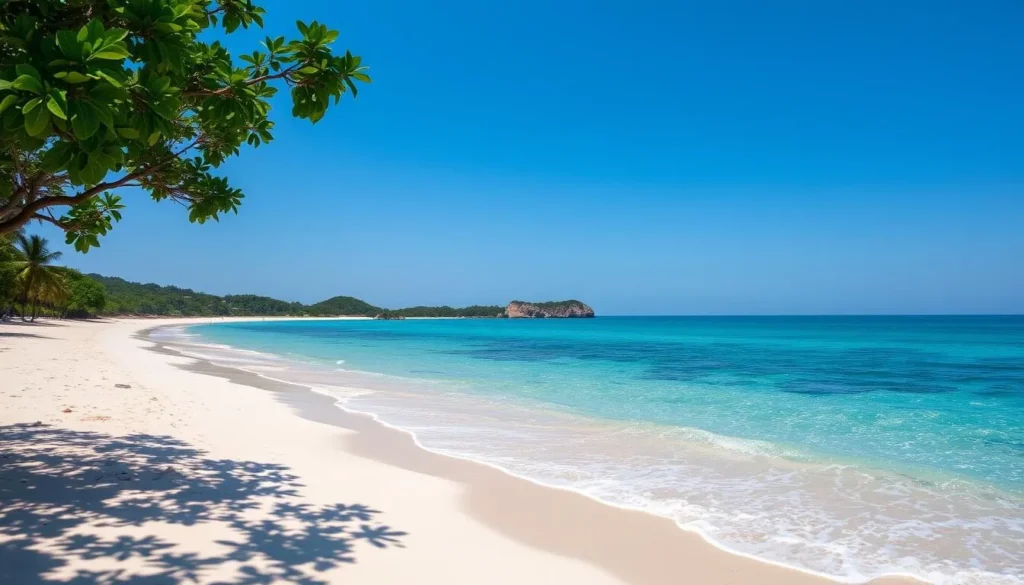
Thuan An Beach
For those looking for a beach experience closer to Hue city, Thuan An Beach is the perfect choice, located just 15km away. This mile-long stretch of powder-white sand slopes gently into a shallow emerald lagoon, backed by a thick curtain of palms and tropical foliage. It’s a relaxed atmosphere where you can enjoy local seafood and soak up the sun.
Thuan An Beach is a popular place among locals and visitors alike, making it an ideal spot for a day out. You can enjoy swimming, sunbathing, and sampling fresh seafood, making for a well-rounded day at the beach.
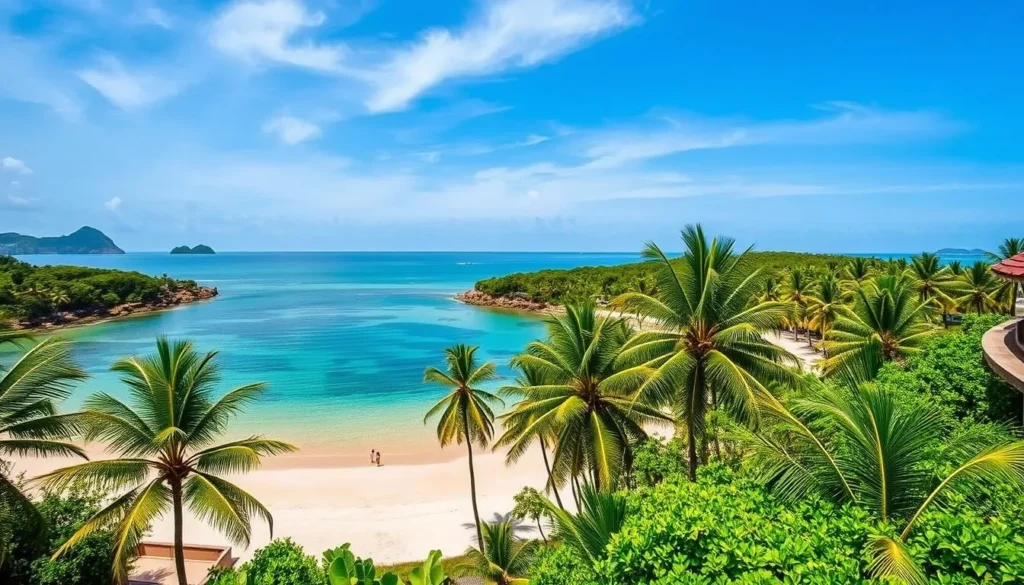
Both Lang Co and Thuan An beaches offer a unique perspective on central Vietnam’s natural beauty, providing a welcome change from the historical sites in Hue. Whether you’re looking to relax or explore, these beaches are must-visit attractions during your stay in Hue.
Day Trips from Hue
With its strategic location, Hue is the perfect starting point for day trips to discover the best of central Vietnam. You can explore the natural beauty and cultural richness of the region through various excursions.
Tam Giang Lagoon
Experience the traditional fishing communities and stunning sunset views at Tam Giang Lagoon, Southeast Asia’s largest brackish water lagoon. Take a half-day tour to enjoy fishing for your seafood dinner while taking in the picturesque views of the lagoon.

Hai Van Pass
Discover the dramatic beauty of Hai Van Pass, also known as the “Ocean Cloud Pass,” with its winding mountain road offering spectacular coastal views and historical significance. This pass is one of the most scenic hillside roads in Vietnam.
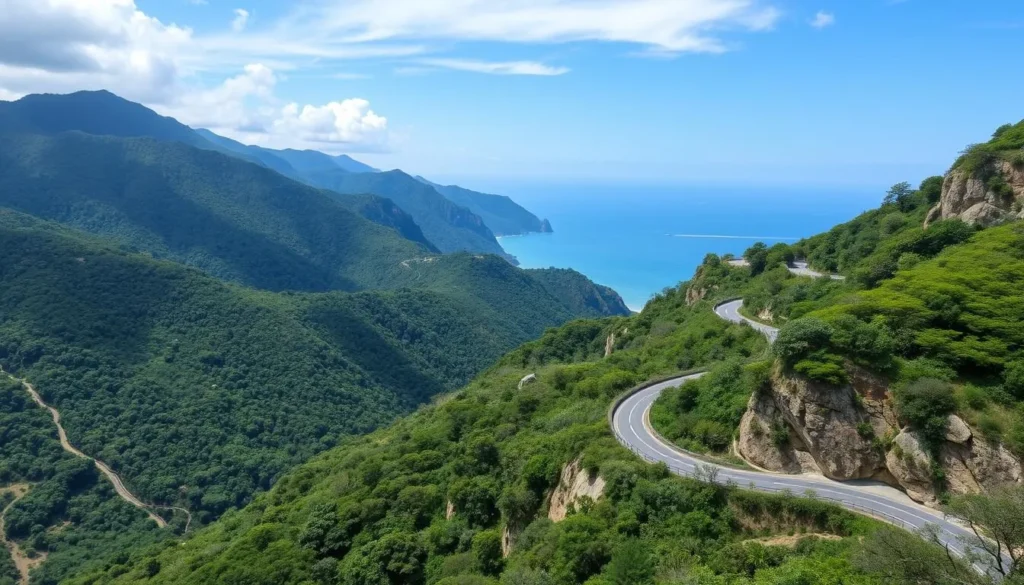
You can also visit Bach Ma National Park, which offers diverse ecosystems, hiking trails, waterfalls, and abundant wildlife just an hour from Hue. Consider organized tours or independent travel to these destinations, and plan your trip according to the best times to visit each location.
Conclusion: Making the Most of Your Visit to Hue
Hue, Vietnam, offers a unique blend of historical exploration, cultural immersion, and natural beauty, making it an ideal travel destination. With its rich history, cultural landmarks, and serene landscapes, Hue is a city that has something for everyone.
To fully appreciate the diverse attractions of Hue, a stay of 3-4 days is recommended. This allows you to visit the Imperial City, explore the Royal Tombs of the Nguyen Dynasty, and take a leisurely cruise along the Perfume River without feeling rushed.
When planning your trip, consider combining city sights with excursions to surrounding areas. Visit the Thien Mu Pagoda, explore the traditional villages, and relax at one of the nearby beaches. Don’t miss the opportunity to experience the local culture by visiting markets and trying the unique Hue cuisine.
To enhance your visit, be mindful of the weather, use appropriate transportation between sites, and respect local customs. By slowing down and embracing Hue’s contemplative atmosphere, you’ll be able to fully appreciate the city’s beauty and charm.
In conclusion, Hue is a destination that offers a rich and varied experience. Whether you’re interested in history, culture, or natural beauty, Hue has something to offer. Plan your visit carefully, and you’ll leave with unforgettable memories of this incredible city.
The above is subject to change.
Check back often to TRAVEL.COM for the latest travel tips and deals.
